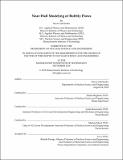| dc.contributor.advisor | Emilio Baglietto. | en_US |
| dc.contributor.author | Lubchenko, Nazar. | en_US |
| dc.contributor.other | Massachusetts Institute of Technology. Department of Nuclear Science and Engineering. | en_US |
| dc.date.accessioned | 2019-07-15T20:37:04Z | |
| dc.date.available | 2019-07-15T20:37:04Z | |
| dc.date.copyright | 2018 | en_US |
| dc.date.issued | 2018 | en_US |
| dc.identifier.uri | https://hdl.handle.net/1721.1/121709 | |
| dc.description | This electronic version was submitted by the student author. The certified thesis is available in the Institute Archives and Special Collections. | en_US |
| dc.description | Thesis: Ph. D., Massachusetts Institute of Technology, Department of Nuclear Science and Engineering, 2018 | en_US |
| dc.description | Cataloged from student-submitted PDF version of thesis. | en_US |
| dc.description | Includes bibliographical references (pages 119-127). | en_US |
| dc.description.abstract | Multiphase computational fluid dynamics (M-CFD) codes are gaining acceptance in the nuclear industry for the prediction of thermal-hydraulic behavior, offering the potential to improve the operation, economics, and safety of current systems, and enhance the design of next generation reactors. The common approach when applying M-CFD methods to the bubbly flow regime is to use an Eulerian-Eulerian two-fluid model, which solves for averaged mass and momentum equations for liquid and gas phases, as well as the k-epsilon turbulence model with modifications to account for the presence of bubbles. The resulting partial differential equations require well-posed boundary conditions, with special treatment at the walls, where there exist strong gradients of all variables. The present work systematically addresses the boundary conditions at solid walls for turbulent bubbly flows. | en_US |
| dc.description.abstract | The complete coupled problem involving six variables is decoupled into three separate tasks, which consider void fraction profile, turbulent quantities, and gas velocity near the wall. Based on available experimental data it is shown that the reduction in void fraction near the wall is a consequence of the bubble shape, and not the wall lubrication effect repelling bubbles from the wall. Aiming at restoring the correct profile, a new wall force is derived from consideration of the interfacial forces balance near the wall. Its performance is evaluated through simulations of bubbly pipe flow experiments, confirming its improvements when compared to previous models. Three phenomena, namely, bubble-induced turbulence, buoyancy of gas, and displacement of liquid by gas, are speculated to have effect on the near-wall turbulent boundary layer. | en_US |
| dc.description.abstract | These effects are incorporated in the Analytical Wall Functions (AWF), which provide quantitative treatment of these bubble effects in the boundary layer. The boundary layer model is validated on the existing experimental data, and the AWF are assessed based on simulations of bubbly pipe flow experiments, as well as at the prototypical reactor conditions. It is demonstrated that most of the effects that arise due to bubbles in the boundary layer can be neglected, and consequently, single phase wall functions can be used in numerical simulations. Finally, through analysis of experimental data, it is suggested that the relative velocity between bubbles and the surrounding liquid does not remain constant throughout the domain in the Eulerian-Eulerian representation of the flow, but instead increases near the wall. A corresponding correction to the drag coefficient is proposed and validated against the experimental data. | en_US |
| dc.description.statementofresponsibility | by Nazar Lubchenko. | en_US |
| dc.format.extent | 137 pages | en_US |
| dc.language.iso | eng | en_US |
| dc.publisher | Massachusetts Institute of Technology | en_US |
| dc.rights | MIT theses are protected by copyright. They may be viewed, downloaded, or printed from this source but further reproduction or distribution in any format is prohibited without written permission. | en_US |
| dc.rights.uri | http://dspace.mit.edu/handle/1721.1/7582 | en_US |
| dc.subject | Nuclear Science and Engineering. | en_US |
| dc.title | Near-wall modeling of bubbly flows | en_US |
| dc.type | Thesis | en_US |
| dc.description.degree | Ph. D. | en_US |
| dc.contributor.department | Massachusetts Institute of Technology. Department of Nuclear Science and Engineering | en_US |
| dc.identifier.oclc | 1103917873 | en_US |
| dc.description.collection | Ph.D. Massachusetts Institute of Technology, Department of Nuclear Science and Engineering | en_US |
| dspace.imported | 2019-07-15T20:37:01Z | en_US |
| mit.thesis.degree | Doctoral | en_US |
| mit.thesis.department | NucEng | en_US |
